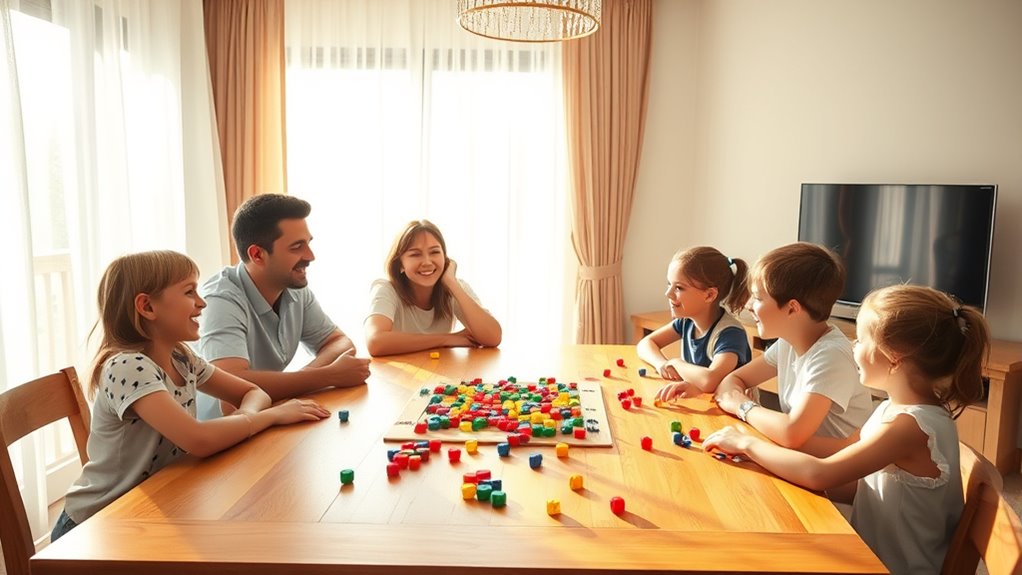One effective way to cut family screen time is to designate specific screen-free times, especially during family meals. This not only encourages face-to-face interactions but also strengthens your family bonds through meaningful conversations. You’ll find that sharing stories and laughter without distractions creates a warm environment. Plus, implementing these boundaries can lead to more imaginative play and exploration. If you want more tips on reducing screen time, just keep going.
Key Takeaways
- Establish specific screen-free times during family meals to enhance connections and meaningful conversations.
- Designate a maximum of 1.5 hours of screen time for kids on school days to promote healthier routines.
- Organize outdoor activities and playdates to encourage physical health and social interaction.
- Utilize tracking apps to monitor screen time usage and facilitate discussions on screen habits.
- Maintain consistency with screen time rules among all family members to create a supportive environment.

As you navigate the challenges of modern parenting, cutting your family’s screen time can feel intimidating, but it’s essential for fostering healthier habits. Start by establishing daily time limits for screen usage; aim for no more than 1.5 hours for your kids on school days. This limit can help them develop healthier routines and encourage imaginative play. When you set these boundaries, you’re not just reducing screen time; you’re opening doors for creativity and exploration that screens often overshadow. Additionally, consider incorporating large indoor plants into your home, as they can create a calming environment that encourages relaxation and reduces the urge to reach for screens.
Cutting screen time fosters healthier habits and creativity; aim for 1.5 hours on school days to encourage imaginative play.
Designate specific screen-free times throughout the week, especially during family meals. This simple act can greatly enhance face-to-face interactions and strengthen family bonds. When you gather around the table without screens, everyone is more likely to engage in meaningful conversations, share experiences, and connect on a deeper level. You might even find that these moments become the highlight of your day, as everyone shares stories and laughter without distractions.
Using tracking apps can also be beneficial in managing screen time. These tools provide insights into how much time your kids spend on devices, allowing you to enforce limits effectively. When you have concrete data, it becomes easier to discuss screen habits with your children and explain the importance of reducing screen exposure.
Encourage open discussions about why these limits matter for their physical health and overall well-being. When kids understand the rationale behind your rules, they’re more likely to embrace them. Additionally, consider how increased smartphone usage among seniors has shown the importance of balancing screen time with real-life interactions.
Engaging in outdoor activities is another effective way to reduce screen time. Organize screen-free playdates in parks or backyards to promote social interaction and physical health. When your kids get outside, they can engage in games that foster teamwork and creativity. Encourage them to explore nature, ride bikes, or play sports. These activities not only keep them active but also help them build friendships and develop social skills.
Lastly, consistency is key. Make sure everyone in your family adheres to the screen time rules you’ve set. When the entire family participates in reducing screen time, it creates a supportive environment.
You’ll notice that your kids are more engaged in imaginative play, have better communication skills, and develop healthier habits over time. Embrace these changes together, and you’ll discover that cutting down on screen time can lead to a more fulfilling and connected family life.
Frequently Asked Questions
How to Reduce Family Screen Time?
To reduce family screen time, start by setting specific limits for everyone.
Designate screen-free zones in your home, like the dining room, to encourage conversations.
Create a daily schedule that includes outdoor activities or board games, making them fun alternatives to screens.
You can also monitor usage with apps, ensuring everyone’s aware of their screen habits.
What Are the 3 C’s of Screen Time?
The 3 C’s of screen time are Content, Context, and Child. You should evaluate the content your family consumes, ensuring it’s age-appropriate and educational.
Next, consider the context: where and when screens are used can make a big difference, especially during meals or family time.
Finally, understand your child’s unique relationship with screens, recognizing their emotional responses and developmental stage.
This approach helps create healthier screen habits for everyone.
How to Take a Break From Screen Time?
You’re glued to that screen like it’s a rare treasure! But hey, it’s time to break free.
Start by designating screen-free moments—meals or bedtime work wonders. Plan an “unplugged day” where you explore the outdoors or immerse yourself in board games with the family.
Create screen-free zones to keep temptation at bay. Trust me, you’ll rediscover the joy of face-to-face conversations and the thrill of real-life adventures!
What Age Should Kids Stop Having Screen Time?
There’s no specific age when kids should stop having screen time, but guidelines suggest managing it based on their developmental stage.
For children under 2, it’s best to avoid screens entirely. From ages 2 to 12, limit it to one hour a day.
For teens and adults, aim for no more than two hours of recreational use.
Balancing screen time with physical activities and real-world interactions is key to healthy development.
Conclusion
By setting aside dedicated family time, you can cut screen time like pruning a garden helps flowers bloom. Engage in activities together—play board games, go for walks, or cook a meal. You’ll not only reduce the hours spent on devices but also strengthen family bonds. Remember, the memories created during these moments are far more valuable than any screen. So, unplug and connect; your family will flourish when you prioritize quality time over screens.









